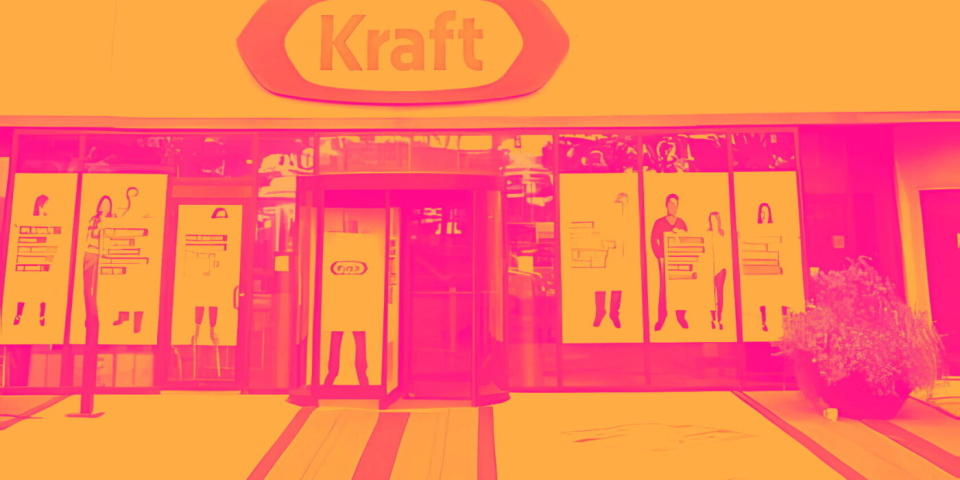Kraft Heinz (NASDAQ:KHC) Misses Q4 Sales Targets

Packaged foods company Kraft Heinz (NASDAQ:KHC) missed analysts' expectations in Q4 FY2023, with revenue down 7.1% year on year to $6.86 billion. It made a non-GAAP profit of $0.78 per share, down from its profit of $0.85 per share in the same quarter last year.
Is now the time to buy Kraft Heinz? Find out by accessing our full research report, it's free.
Kraft Heinz (KHC) Q4 FY2023 Highlights:
Revenue: $6.86 billion vs analyst estimates of $6.98 billion (1.8% miss)
EPS (non-GAAP): $0.78 vs analyst estimates of $0.77 (1.4% beat)
Guidance for full year 2024 EPS (non-GAAP): $3.04 at the midpoint vs analyst estimates of $3.02 (0.7% beat)
Free Cash Flow of $1.12 billion, up 46.7% from the previous quarter
Gross Margin (GAAP): 33.8%, up from 32.2% in the same quarter last year (miss vs. expectations of 34.3%)
Organic Revenue was down 0.7% year on year (miss vs. expectations of up 0.5% year on year)
Sales Volumes were down 4.4% year on year
Market Capitalization: $44.31 billion
“I’m proud of the results we delivered in 2023 and the progress we’ve made as a Company throughout the year,” said Kraft Heinz CEO Carlos Abrams-Rivera.
The result of a 2015 mega-merger between Kraft and Heinz, Kraft Heinz (NASDAQ:KHC) is a packaged foods giant whose products span coffee to cheese to packaged meat.
Packaged Food
As America industrialized and moved away from an agricultural economy, people faced more demands on their time. Packaged foods emerged as a solution offering convenience to the evolving American family, whether it be canned goods, prepared meals, or snacks. Today, Americans seek brands that are high in quality, reliable, and reasonably priced. Furthermore, there's a growing emphasis on health-conscious and sustainable food options. Packaged food stocks are considered resilient investments. People always need to eat, so these companies can enjoy consistent demand as long as they stay on top of changing consumer preferences.The industry spans from multinational corporations to smaller specialized firms and is subject to food safety and labeling regulations.
Sales Growth
Kraft Heinz is one of the most widely recognized consumer staples companies in the world. Its influence over consumers gives it extremely high negotiating leverage with distributors, enabling it to pick and choose where it sells its products (a luxury many don't have).
As you can see below, the company's revenue was flat over the last three years as consumers bought slightly less of its products. We'll explore what this means in the "Volume Growth" section.

This quarter, Kraft Heinz missed Wall Street's estimates and reported a rather uninspiring 7.1% year-on-year revenue decline, generating $6.86 billion in revenue. Looking ahead, Wall Street expects sales to grow 1.2% over the next 12 months, an acceleration from this quarter.
Unless you’ve been living under a rock, it should be obvious by now that generative AI is going to have a huge impact on how large corporations do business. While Nvidia and AMD are trading close to all-time highs, we prefer a lesser-known (but still profitable) semiconductor stock benefitting from the rise of AI. Click here to access our free report on our favorite semiconductor growth story.
Volume Growth
Revenue growth can be broken down into changes in price and volume (the number of units sold). While both are important, volume is the lifeblood of a successful staples business as there’s a ceiling to what consumers will pay for everyday goods; they can always trade down to non-branded products if the branded versions are too expensive.
To analyze whether Kraft Heinz generated its growth from changes in price or volume, we can compare its volume growth to its organic revenue growth, which excludes non-fundamental impacts on company financials like mergers and currency fluctuations.
Over the last two years, Kraft Heinz's average quarterly sales volumes have shrunk by 2.7%. This decrease isn't ideal as the quantity demanded for consumer staples products is typically stable. Luckily, Kraft Heinz was able to offset fewer customers purchasing its products by charging higher prices, enabling it to generate 6.7% average organic revenue growth. We hope the company can grow its volumes soon, however, as consistent price increases (on top of inflation) aren't sustainable over the long term unless the business is really really special.

In Kraft Heinz's Q4 2023, sales volumes dropped 4.4% year on year. This result was a further deceleration from the 4.8% year-on-year decline it posted 12 months ago, showing the business is struggling to push its products.
Key Takeaways from Kraft Heinz's Q4 Results
The company's organic revenue unfortunately missed analysts' expectations, leading to a total revenue miss. Gross margin also came in below expectations. With regards to guidance, full year EPS is projected to be slightly above Wall Street Consensus estimates. Overall, the results were mixed. The stock is flat after reporting and currently trades at $36.14 per share.
So should you invest in Kraft Heinz right now? When making that decision, it's important to consider its valuation, business qualities, as well as what has happened in the latest quarter. We cover that in our actionable full research report which you can read here, it's free.
